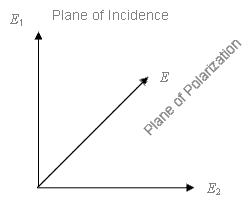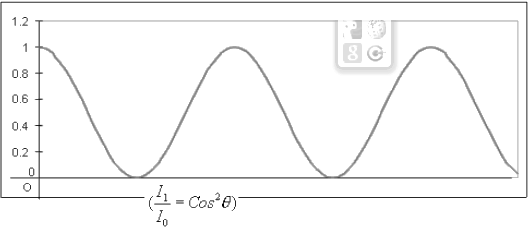SKEDSOFT
The electric field E of the light coming out of the polarizer (polarized light) can be resolved in two mutually perpendicular components. E1 component, having electric field in the plane of the incidence of analyzer and other E2 perpendicular to it as shown in Fig. 3.

fig..(3) Components of electric filed in two mutually perpendicular direction
The component E1 will pass through the analyzer completely. Thus if the plane of the polarizer is making an angle of ![]() with the pass plane of the analyzer then the amplitude of the light passing through the analyzer is
with the pass plane of the analyzer then the amplitude of the light passing through the analyzer is
![]() ----------------------------------------(3)
----------------------------------------(3)
and corresponding intensity
![]() --------------------------(4)
--------------------------(4)
where I1 is the intensity of light coming out of analyzer and I is that of incident on it. Equation 4 is known as the Malus law. The plot of I1 verses the orientation angle is shown in fig 4

fig..(4) vairiation of intensity as a function of rotator of analyzer
The pile of glass plates can be replaced by certain special type of material called as polarizing material (or Polaroid) which allows only specific polarized light to pass completely (neglecting the absorption). A randomly polarized light falling on to the polarizer will allow to transmit only one particular component of electric filed (define by the pass plane of the polarizer) thus generating the plane polarized light. A second polarizer called as analyzer can detect it. Malus law given by eq (4) will hole, in this case q will be the angle between the pass plane of polarizer and analyzer.